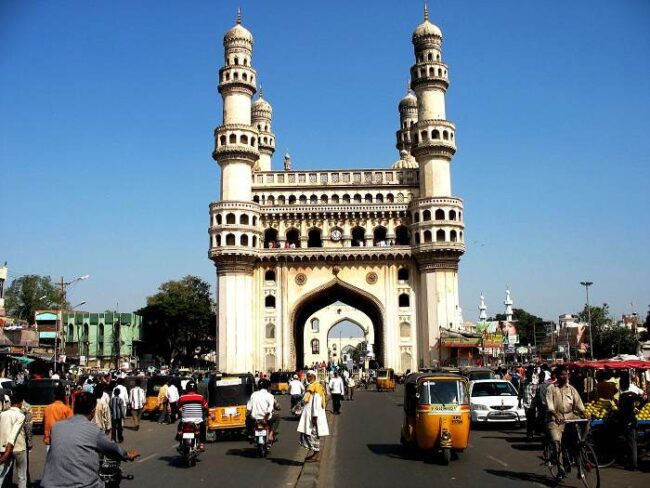Hyderabad is most famous for its charming minarets – the Charminar. The city is often identified with the majestic Charminar, which stands at the center of the old city in its entire splendour amidst the colourful shops of Laad Bazaar with its glittering traditional bangles. Often called “The Arc de triomphe of the East”, Charminar is a beautiful structure with four intricately carved minarets. Enormous in its size, this imposing monument exudes a charm that is more than 400 years old. Many people know Charminar as a historical monument constructed by Mohammad Quli Qutub Shah in 1591. But there are many historical facts that are associated with this great monument. With the restoration work of the Charminar in full swing many interesting facts about it are coming to light.
Hyderabad’s oldest mosque:
Tucked away on the second floor of the Charminar is the oldest mosque in the city. Constructed by Mohammad Quli Qutub Shah in 1590-91, the mosque lies at the western end of the monument and is considered to be one of the most beautiful mosques the Qutub Shahi artisans ever built. There are 45 prayer spaces with a large open space in front of the mosque. Built with lime, mortar and granite, every section of the mosque is exquisitely carved. The Mehrab, from where the Imam leads the prayer is made of black stone and is intricately designed and neatly polished representing traditional Islamic architecture There are forty arches in the mosque on all sides.

Insignia of the Nizams:
Charminar was the official insignia of the erstwhile Hyderabad state. Besides using it in several official documents, it was extensively used in the currency which mostly consisted of gold, silver and copper coins. The monument as it looks from the Eastern side from the Kotla Alijah road was engraved on all the coins while giving the details like the year of mintage and the initial of the ruler. The use of the coins bearing Charminar continued till the merger of the erstwhile Hyderabad state with the Indian union in 1948.
Hyderabad’s first school:
The original name of Charminar was ‘Madarsa'(School). It was only at the end of Qutub Shahi period in 1687 that the monument became popular as Charminar. Charminar has the distinction of being the first school in the entire Qutub Shahi kingdom. It is believed Arabic & Persian were the main subjects that were taught in the Madarsa. The book “Landmarks of the Deccan” written by SA Asgar Bilgrami, former Director of Archeology and the then Assistant Secretary to Nizam’s Government has a mention about a school that was run on the first floor of the Charminar. Quoting Monsier Thevenot, a French traveller, Bilgrami wrote, “In the Qutub Shahi period the first storey was used as ‘Madarsa’ and the cubicles were used by the students.” With the setting up of several ‘Madarsas’ in the city, probably the ‘Madarsa’ of Charminar lost its importance and with the end of Qutub Shahi dynasty, imparting of education was stopped there. Subsequently, the Charminar lost its original name as ‘Madarsa’.
Monumental Goodluck charm:
It is a common belief in the old city that anyone carrying a replica or picture of the Charminar will be lucky. It is a belief as old as the monument. Historians believe that the Charminar was built to mark the end of plague in the city. A stone on the Southeast end of the Charminar is believed to bring luck. Visitors used to touch the stone believing its good fortune would rub off on them. Later the Bhagyalaxmi temple was constructed on the same place. Similar beliefs are associated with coins bearing the Charminar insignia. According to 75 year old Suresh Agarwal of Hussaini Alam, people having such a coin will never become poor. The belief was so strong among Marwari families that they preserved ‘Charminar’ coins though they went out of circulation in 1948.
One of the four Minarets not original:
One of the four minarets of the Charminar is not original. It broke into pieces after being struck by lightning in 1707 AD, but was later reconstructed in a way that no one can differentiate it from the other three minarets. Though all the features of the broken minaret – The South-West one facing the Mecca Masjid were restored, the architecture probably failed to maintain the same quality of construction due to which the minaret has developed cracks.
